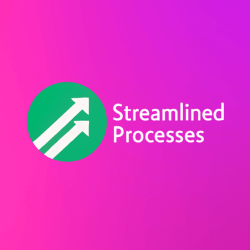For Process Efficiency Strategies, see our main page here.
Why Process Efficiency Matters More Than Ever
Efficiency isn’t just about speed—it’s about doing the right things at the right time with the right resources. As industries shift due to digital transformation and global competition, improving process efficiency has become an essential driver of sustainability and growth.
For example, during the pandemic, companies with agile processes adapted faster to remote work and supply chain disruptions. Meanwhile, less efficient competitors struggled to respond. Therefore, mastering Process Efficiency Strategies gives businesses a clear edge during change and uncertainty.
Key Components of Successful Process Efficiency Strategies
To build and sustain efficient processes, organizations must align people, technology, and goals. A solid strategy includes measurable outcomes, collaborative planning, and a commitment to continuous improvement.
- Clear objectives: Define what success looks like in terms of cost, time, and quality.
- Employee involvement: Those closest to the work often provide the best improvement ideas.
- Technology integration: Use software and automation to reduce repetition and errors.
- Feedback loops: Regular checks ensure the process evolves with business needs.
Most importantly, effective Process Efficiency Strategies reject a one-size-fits-all approach. They’re tailored to your specific workflow and industry context.
Process Mapping: A Foundation for Efficiency
Before you can improve a process, you need to understand it. That’s where process mapping comes in. It visually outlines each step from start to finish, identifying handoffs, delays, and resource waste.
For example, a logistics company may discover through mapping that package delays often occur during warehouse intake—not transportation. As a result, solutions focus on staffing and automation at intake, not on delivery vehicles.
Common process map types include:
- Flowcharts: Great for high-level overviews.
- SIPOC diagrams: Show suppliers, inputs, processes, outputs, and customers.
- Value stream maps: Ideal for lean initiatives that eliminate non-value-adding steps.
Mapping lays the groundwork for applying Process Efficiency Strategies in a data-driven way.
Popular Process Efficiency Strategies in Today’s Market
While each organization is unique, some Process Efficiency Strategies have proven effective across industries. Here are a few worth considering:
- Lean Methodology: Focuses on removing waste and maximizing value.
- Six Sigma: Uses data to reduce defects and improve quality.
- Kaizen: Promotes continuous, small improvements by engaging all employees.
- BPM Tools: Business Process Management software automates, tracks, and optimizes workflows.
- Agile Practices: Ideal for dynamic environments like IT or product development.
For instance, GE famously used Six Sigma to save over $10 billion in the 1990s—a clear illustration of how structured efficiency strategies impact the bottom line.
Measuring and Monitoring Efficiency Improvements
Implementing Process Efficiency Strategies is only the beginning. Measuring their impact ensures you adjust when needed. Metrics can include time to completion, cost per unit, customer satisfaction, and error rates.
Digitally mature companies often use real-time dashboards to monitor performance. For example, a customer service team may track resolution times via CRM software, spotting and correcting delays as they occur.
On the other hand, companies without feedback systems may continue inefficient practices unknowingly. Therefore, data transparency is crucial to long-term success.
Common Pitfalls When Applying Efficiency Tactics
Even with the right tools, process improvement can falter. Knowing what to avoid is as important as taking action:
- Over-automation: Automating a flawed process only makes problems faster and bigger.
- Ignoring people: Processes rely on humans. Training, morale, and feedback must be part of the strategy.
- Lacking clear ownership: Without accountability, initiatives often fade without results.
- No baseline: Failing to document the current state makes success impossible to measure.
To clarify, even the best Process Efficiency Strategies fail without proper foundation and engagement. Set realistic goals, and bring your team along for the ride.
Emerging Trends in Process Efficiency
Technology plays a major role in evolving how we think about efficiency. Companies now use AI, machine learning, and robotics to streamline both digital and physical processes.
For example, in manufacturing, predictive maintenance tools use AI to anticipate machine failures. As a result, downtime is reduced without over-investing in repairs. Similarly, smart scheduling tools in staffing ensure better coverage during peak hours.
Another growing trend is hyperautomation—which combines multiple tech tools like RPA, AI, and low-code platforms to rapidly evolve business operations. Gartner reports this as a top trend through 2024.
FAQs on Process Efficiency Strategies
What’s the first step in improving process efficiency?
Start by understanding your current processes. Mapping them out helps spot inefficiencies and sets the stage for improvements.
How often should processes be reviewed?
At minimum, conduct annual reviews. However, high-impact areas with frequent changes may need quarterly evaluations.
Are efficiency strategies only for large companies?
No, small and mid-sized businesses can benefit greatly. In fact, smaller firms can often adopt changes faster due to agility.
How do we involve staff in process improvements?
Use workshops, surveys, and pilot programs. Employees are more engaged when they help design solutions they’ll use.
Can AI help with Process Efficiency Strategies?
Yes. AI tools support improvements by analyzing trends, predicting errors, and automating tasks—improving accuracy and speed.
Case Study: Supply Chain Optimization Using Process Efficiency Strategies
A leading electronics distributor applied Process Efficiency Strategies to fix delays in international shipping. First, they mapped each step and found customs documentation took too long due to manual entry. They then implemented OCR (Optical Character Recognition) scanning and integrated it with customs software.
As a result, clearance time dropped by 33%, saving $1.2 million annually in shipping penalties and inventory backlogs. The success came not from working harder—but from working smarter, aligning tools with process gaps.
Conclusion: Turning Strategy Into Value
Process Efficiency Strategies aren’t just buzzwords—they’re practical systems that reduce waste, increase speed, and improve services. Organizations that commit to thoughtful, tailored efficiency plans build cultures of excellence that last. When processes run better, so does the business.
This article was created with the assistance of AI tools and reviewed by our team at Streamlined Processes LLC to ensure accuracy and relevance.
Follow us on Facebook here.

